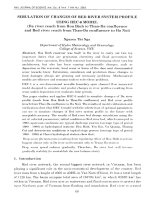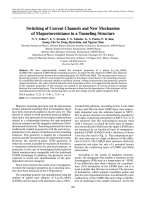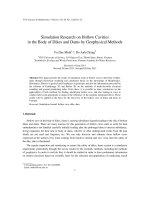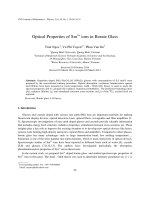DSpace at VNU: Simulation study of microscopic bubbles in amorphous alloy Co81.5B18.5
Bạn đang xem bản rút gọn của tài liệu. Xem và tải ngay bản đầy đủ của tài liệu tại đây (680.2 KB, 7 trang )
VNU Journal of Science, Mathematics - Physics 26 (2010) 29-35
Simulation study of microscopic bubbles in amorphous alloy
Cou.5813.5
Pham Huu Kienl,*, Pham Khac Hung1, Vu Van Hung2
2Department
rDeparlmenl of Computalional Physics, Hanoi (Iniversity of Technology
of Physics, Hanoi Nalional University of Education, 136 Xuan Thuy, Cau Giay, Hanoi, Vietnam
Received 8 September 2009
Abstract. Simulation of the diffirsion mechanism via microscopic bubbles in amorphous materials is carried out using the statistical relaxation models Cos.5Bft.5 containing 2 x 105
atoms. The present work is focused on the role of these bubbles for self-diffirsion in amorphous
solids. It was found that the numbers'of the vacancy bubbles in amorphous Cog1."B1g ,b vary
from 1.4 x 10-3 to 4 x 10-3 per atom depending on the relaxation degree. The simulation
shows the collective character of the atomic movement upon diffirsion atoms moving. Due to
the large size in comparison with B atom, the jump of a Co diffirses atom leads to a significant local rearrangement of the atoms located near the VB. Meanwhile, B diffuses like the
movement of an interstitial impurity through the boron-VB. Diffirsion coeffrcients have been
calculated via the vacancy bubbles and they are consistent with experimental data. The effect
of the relaxation is also investigated and interpreted as a result of vacancy-bubble annihilation
during thermal annealing. Keywords:
Keyworks: Bubbles; Amorphous alloys; Vacancy bubbles; Diftrsion mechanism; Statistical
relaxation.
1. Introduction
The diffusion behavior in amorphous materials have been investigated by both experiment and
computer simulation for a long time [1-23]. For amorphous alloys (AMAs), the diffi.rsion coefficient
of tracer atoms in well-relaxed specimens decreases compared to that in as-quenched ones [-11].
Generally, the diffusivity in AMAs is interpreted as the quasi-vacancies in super-saturation is reduced
during thermal annealing until the relaxation is over, and the diffirsion coefficient reaches its final value.
In well-relaxed state, conversely, the tracer atoms diffirse via the collective movement of a group of
neighboring atoms. However, the experimental measurements [0-16] on the isotope effect, pressure
dependence and irradiation-enhanced diffi.rsivity are sometimes in contradiction to the prediction of
the diffirsion mechanism described above. In addition, the definition of the quasi-vacancy is not clear.
Molecular dynamic (MD) simulations reveal that the vacancies are unstable in an amorphous matrix
[ 5, l6]. In close inspection of the MD model, a continuous spectrum of small spherical voids is found
in both Fe-P and Co-B models [7], but their size is less than the atomic size. Regarding the collective
atomic jumps, the free volume and twolevel states theories are employed to interpret the specific
* Coresponding author. E-mail:
30
P.H. Kien et ql.
/ WU Journal of Science, Mathemqtics
- Physics 26 (2010) 29-35
diffirsion behavior in AMAs ll4-201. However, the correlations of diftrsion in amorphous 7z6eNa6
and .F ea6NiqoBzo alloys [2] show that the atomic jump process in amorphous alloys seems to be
cooperative in nature; details of such process have yet to be clarified. Recently, we have reported that
the evidence of microscopic bubbles has been found in amorphous FessB2s alloys [22]. A systematic
study of these bubbles should be carried out in other amorphous systems in order to interpret the
possible diffirsion mechanism of tracer atoms in AMAs. This paper focus on the microscopic bubbles
and the diffi.rsioh mechnism via these bubbles in AMAs Co{.sBft.s.
2. Computation procedure
Fig.
l.
The schematic illustration of bubbles in AMAs.
Amorphous models containing 2 x 105 atoms are constructed by the continuous static relaxation
(SR) method. The SR method is in fact the molecular dynamic method in which the kinetic energy is
equal to zero and the volume is constant. Accordingly, each atom in the system moves in the direction
of the force acting on the given atom from all remaining ones by a length dr. This movement is
repeated many times until the system reaches to equilibrium state. More details on the SR method can
be found elsewhere 117,221. The initial configuration is generated by randomly placing all atoms in a
cubic with periodic boundary conditions. The Pak-Doyama effective pair potential in ref. [22] is used
and the density is adopted from a real amorphous alloy ( 8.3g lcm3). This model, as called model A,
is heated over 106 SR steps to reach the equilibrium state. The SR step length is equal to 0.01 A.
The validity of the constructed model has been tested such that the pair distribution functions (PDFs)
are reproduced well. To investigate the effect of relaxation, two additional models (model B and C)
with the same density as.the model A are constructed, but of which the potential energy is lower. The
model B is constructed by relaxing the model A within 100 SR steps with a SR step length of 0.4
A. This is like shaking the atomic arrangement in the model A. Then, the model B is continuously
relaxed with a SR step length of 0.01 A, until the system reaches to a new equilibrium state. This
procedure is repeated many times such that the potential ene of the system attains'the desired value.
The model C is obtained by an analogous procedure. By using the models obtained, the microscopic
bubbles are examined. The microscopic bubbles in AMAs Cou.sBft.5 are also dinoted in ref 122).
Figure 1 presents the new 5-bubble (Fig.l b) is found in a solid after atom-DA in the old 5-bubble
(Fig.1 a) is completed and new neighboring atoms.
P.H. Kien et al.
/ WU
Journal of Science, Mqthemalics - Physics 26 (2010) 29'35
31
3. Results and discussions
Amor. CoBtsBtE5
This wotk
. Exp. [231
o
oE
L'
G
F
1
4A
R ad
Fis..
irl
d
bta
n
ce r, . nostro m
2. The total radial distribution function of AMA Cos.5B6.5
To test the validity of the constructed models, we have compared our the obtained total radial
distribution function (RDF) with experimental data. The total RDF is determined as follow:
g(r):
r1)
where c1 and c2 arra the concentration constants of Co and B, respectively; h and f2 are the scattering
constants of Co and B, respectively; g1(r),gn(r) and g22(r) are the partial RDFs of Co-Co, Co-B
and B-B pairs, respectively. As observed in figure 2, the total RDF is good in agreement with the
experimental data in 1I5,23). As shown in figure 2,thetotal RDF have a split second peak like that
observed experimentally, which is thought to be related to the existence of an icosahedral form in the
system. This split peak is also a typical feature for binary metal-metalloid amorphous alloys.
Table
l.
The number of bubbles
Model
The mean potential
energy per atom, eV
A
B
c
-0.91867
-0.92996
-0.93 8l
I
Number of atoms nB
5
6
7
I
>9
l09l 159 29
214739 30231 987 125 2
2n43t 27196 413 51 3
22t633 30882
The number of bubbles calculated in AMA Cos15B1.5 models are listed table l. As'observed in table
l, all models contain more than one bubble per atom. The number of bubbles in the model decreases
with the decrease of the mean potential energy per atom. This means that the well-relored model
(model C) has a smaller number of bubbles compared to the as-quenched model (model A). This trend
is also observed by the distribution of bubble radius shown in table 2. lt can be seen that the number
32
P.H. Kien et al.
/ WU
Journal of Science, Mqthemqlics - Physics 26 (2010) 29-35
of large bubbles, those with a radius larger than 1.5 A, in the well-relaxed model is smaller than that
in the less-relaxed model,
o
b
v
A
0
v
I
0
e
o
f
j
o
d
ri
-r
o.5
1.0
D
1.5
2.O
ktan ce, an gstrom
Fig. 3. Potential energy profile of atoms moving from their site
to the center of the CST; a, b, c, d and e belong to VB in AMAs.
As in our previous work [21], we calculate the potential energy variation of all neighboring
atoms as they move step by step on a line confiecting their initial equilibrium position and the centerof
the CST. The potential energy profiles (PEP) for an atom moving into the bubbles are shown in figure
3. Some type-PEPs are found in the models. For the type-PEP I the PEP increases monotonously. It
indicates that the neighboring atom cannot jump into the bubble due to avery large energy banier. For
the type-PEP a, b, c, d and e, a mrximum of the PEP is observed. It implies that these typical PEPs
permit a tracer atom jumping into the bubbles. The bubbles with the neighboring atoms having the
type-PEP a,b, c, d and e play a role as a diffi.rsion defect like a vacancy in crystal. These bubbles are
called vacancy bubbles (VB). The atoms attaining the type-PEP a, b, c, d and e are called the diffirsing
atom (DA). The number of VBs in the models is presented in table 3. There are two kinds of VBs:
cobalt- and boron-VB corresponding to the cobalt- and boron-DA, respectively. As listed in table 3,
the number of both nso- rnd nn-YB in the less-relaxed model is larger than that in the well-relaxed
model.
Figure 4 shows the distributions of site energy and potential barrier height for DAs. The potential
barrier height is determined by the difference between the maximum point of the PEP and the site
energy of DAs. These distributions, for all models considered, have a Gaussian form. The well-relaxed
model has the higher peak compared to the less-relaxed model.
In order to inspect the collective atomic movement of atoms in AMA Co$5Bft.s upon DA
moving, the DA is displaced into the center of the CST after the VBs are determined. Then, the system
is relaxed until it reaches a new equilibrium. This process is called \the DA moving). Table 3 presents
the mean square displacements after the DA moving completed, and the 126" and r2u for the individual
ith run are shown in figure 5. In the model C, the mostly fluctuates around 4.3 A for the boron-DA
while it decreases closely to zero in the case of the cobalt-DA. Due to jumping distance of the DA in
therangeof 1.6to 1.9 Atheboron-DAcontributesthedominantpartof r2nt,e.g. otherBatomsmove
P.H. Kien et at.
/ wu
05
Journal of Science, Mathematics - Physi'cs 26 (2010) 29-i5
33
*
a ModrlA
A Mod.l B
* Mod.l C
A
03
aa
c
o
*
E o,
IL
.6
at
01
*r*
^e
la
'i..a
*a*
s*
taa
-24 -l.8 -1.2 -06 00 00 06 '1.2
18
Energy, ev
Fig. 4. The distributions of site energy (left) and energy barrier (right) for DAs.
15
E10
65
6U
c0
E10
OJ
E5
E
.90
u{5
0
S,o
o
o5
0
F.
20 30
40
50
B(
lndex of runs
Fig. 5. The square displacements of Co and B atoms, r2go,
and r2uu for the
ith run of DA moving'
not far from their initial positions under the DA moving. In contrasted with the model C, the value of
r2"on in model A and B is significantly larger than 4.3 A and sometimes reaches to 14 A for the case
of cobalt-DA. This result shows the collective character of the atomic movement is mainly related to
cobalt-DA moving. Due to the large size in comparison with B atom, the jump of a Co atom leads to
a significant local rearrangement of the atoms located near the VB. Meanwhile, boron diffirses like the
movement of an interstitial impurity through the boron-VB. As such, the microscopic VBs play a role
like meaning in the case of diffi,rsion in crystal, and the diffirsion mechanism performed as follows:
one DA (Co or B) jumps into a VB and the present VB disappears, but another !B may be created
in an amorphous matrix due to the collectively atomic movement upon DA moving (see
figure 1). A result of collective movement of a group of atoms is that some bubbles become VBs.
These VBs are unlike the quasi-vacancies described in [4-6] which move over a certain distance until
somewhere
they are annihilated at a source.
34
Journal of science, Mathemalics - Physics 26 (2010) 29-35
/ wU
p.H. Kien el al.
TabIe
RB, A
1.4
Model A
Model B
83
8308
Model C
8509
l6
2. The radii distribution of bubbles
1.6
t.7
l8
s4781
70368
75604
75614
72527
71499
l5
67368
2.1 > 2.2
1.9
2.0
39570
s628
2015
50074
36676
3713
1205
350
242
4',7872
35678
2301
616
85
162
39
rable s. The number of vBs and the mean square displacement upon DA moving.
) in A2 are the mean square displacement
),1
Here (
"bo DA"2n
jumps into the VB, respectively; frCo-v BtnB-vB
of Co and B atoms as
are the numbers of cobalt- and boron-VB, respectively
boron{DA
cobalt-DA
lrv^)
1r'a )
t.164
1.834
4.947
0.1 93
0.807
0.576
4.332
Model
TLCo-V B
nB-vB
A
249
538
8.951
95
354
6.107
236
6202
0.184
B
C
46
1r'o )
4.301
The diffusion coeffrcient of the models is calculated as denoted inlzll..From the si lation
x 1g-re*2t-r u1
data, we get Dg.: 1.5 x 10-20 to 6.7 x70-2om2s-1 and DB:1.1 x 10-1e to 3.9
This result
593 K, where Dgo and Ds arethe diffirsion coeffrcient of cobalt and boron, respectively.
x
10-23m2s-r
to
6.5
10-20
is consistent with experimental data for amorphow CoTsNfuaBz(Dco 10-1: to 3'5 x10-20m2s-r at593 - 600 K)[3,22]' The
and FeasNaoBzo(Dn
at663 K)
uOl,
-
diffirsion coefficient of Co and B atoms in the well-relaxed model is smaller than that in the less-relaxed
model. As regards the relaxation effect, the simulation shows that the diftrsion coeffrcient decreases
model is
due to the loss of VBs upon the relaxation (see table 3). The loss of VBs in the well-relaxed
source where
concerned with the atomic atrangement within the amorphous matrix, but not due to the
models
quasi-vacancy
[1-4]'
the diffi.rsion effect moves to, which has been described by the
4. Conclution
The structure of amorphous Cos1.5B1s.5 models containing 2 x 105 atoms with the Pak-Doyama
with the experimental data. A large number of VBs are found
effective potentials is in good agre
in these models. It is in the range 1.4 x 10-3 to 4 x 10-3 per atom depending on the relaxation
VB
degree. The VB could be a diftrsion vehicle as a vacancy in the crystal i'e' one DA in the
diffirsion
could move into the CST and present an elemental diffusion jump. In other works, a new
neighboring
mechanism is presented in that a DA jumps into the VB, then the collective movement of
somewhere
created
may
be
atoms starts. Consequently, the present VB disappears, but another VB
in the amorphous matrix. The diffirsion coeffrcients of Co and B atoms are calculated via the VBs
upon
detected, and the result is consistent with the experimental data. The decrease in the diftrsivity
the relaxation results in the VB annihilation. This indicates that the VB is unlike the quasi-vacancy,
which is previously used to interpret the relaxation effect'
Acknowledgments. This work was supported financially by a cluster system with 50 PC nodes at the
Hish Performance Calculation Center, Hanoi University of Technology.
P.H. Kien et ql.
/ WU
Journal of Science, Mathematics - Physics 26 (2010) 29-35
References
[]
J. Horvath, J. Ott, K. Pfahler, W Ulfert, Mater. Sci. Eng, 97 (1988) 409.
J. Pavlovsky, W. Ulfert, W. Frank, Mater. Chem. Phys, 36 (1994) 383.
W. Frank, A. Homer, P. Scharwaechter, H. Kronmiiler, Mater. Sci. Eng, 97 (1988) 415.
A. K. Tyagit, M.P. Macht, V. Naundod Acta Metall, Mater 39 (1991) 609.
T. Schuler, NanoStruct. Mater, 6 (1995) 863.
[2]
[3]
[4]
[5]
[6] S. Flege, U. Fecher, H. Hahn, J. Non-Cryst. Solid"s, 270 (2000) 123.
[7] A. Griesche, Maten Sci. Eng, 4375 (2004)285.
[8] A. van den Beukel, J. Sietsma, Maten Sci. Eng, A 134 (1991) 935
t9l S.K. Sharma, S. Banerjee, Kuldeep, A.K. Jam, Acta Metall 36 (1988)
!01 J. Du Plessis, G. N. van Wyk, Appl. Surf. Sci 40 (1990) 303.
Il]
2l
3l
4l
5l
6l
7l
8l
9l
201
[21]
I22l
[23]
1683.
Y. Limoge,J. Non-Cryst. Solids ll7-ll8 (1990) 708.
Y. Limoge, Acta Metall. Mater 38 (1990) 1733.
R.S. Averback, MRS Bulletin 16 (1991) 47.
\'. Limoge, Mater Sci. Eng A 226-228 (1997) 228.
P.K. Hung, H.V. Hue, L.T. Vinh,l Non-Cryst. Solids 352 (2006) 3332
A. Zhu, G.J. Shiflet, S.J. Poon, Acta Materialtd 56 (2008) 3550.
D. Leon et al., Mater. Sci. Eng A 226-228 (1997) 296.
224 (1998) 122.
V. Naundorf et al., J. Non-Cryst.
B.K. Belashchenko, V.V. Hoang, P.K. Hung, J. Non-Cryst. Solids, 276 (2000) 169.
G.S. Chadha et al., Phys. Stat. Sol, A 63 (2) (1981) 625.
P.K. Hung, P.H. Kien and L.T. Vinh, J. phys.: Candens. Matter, 22 Q0l0) 035401.
W. Ulfert et al., Cryst. Latt. Deft Amorph. Mater, 18 (1989) 519.
P. Lamparter et. al., Z. Naturforsch, 6 (1981) 165.
So ,
35









